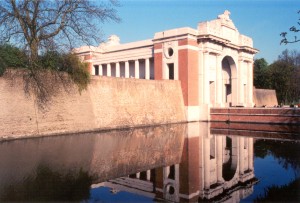He was a carpenter suffering idleness following a severely disabling work accident and looking for some activity to occupy his idle hours. He had to keep his hands busy to keep his mind off on his constant pain. He could also not escape from where he lived. Ivan Sinnaeve lived in the heart of the Ypres battlefield of the First World War.
Ypres was a provincial town whose glory days were in the Middle Ages. It was seldom thought of outside the region until the opening months of the war. The initial German invasion of 1914 had carried across most of tiny Belgium before being stopped at the gates of the city by an Allied Army of French, Belgian and British soldiers. However, the action had left Ypres at the base of a protruding salient into enemy lines under continuous observation from enemy controlled high ground. For the next four years the German Army tried to eliminate the salient and the British Army defended it.
Ypres was shelled, bombed, cursed, and died for thousands of times over. In military texts the battles around Ypres are given numerical titles; the 1st Battle of Ypres, the 2nd Battle of Ypres, the 3rd, the 4th. To the survivors, however, the battles have other names; the Gas Attack – the first use of poison gas in warfare in April 1915; Messines Ridge – the simultaneous explosion of nineteen mine shafts under German lines which obliterated 10,000 soldiers; and the ultimate obscenity – the Battle of Passchendaele.
Passchendaele was trenches filled with water by seemingly unending rainfall; it was continuous artillery bombardment creating a moonscape of mud and water filled shell craters; it was the suffocating necessity of wearing gas masks; Very lights illuminating the barren landscape at night; enemy barbed wire needing to be cut or friendly wire needing to be repaired; machine guns spattering across the mire during the night. It was the total absence of dry clothes, warm feet, hot food, and sleep. Passchendaele was wounded men slowly slipping down the side of ditches to drown in the mud.
After the war, the Commonwealth War Graves Commission erected a memorial to the men whose bodies had not been recovered from such a hellish battlefield. At the exit of Ypres towards Menin, Belgium, the passage closest to the battlefield, they built the Menin Gate Memorial. On the memorial’s walls, white limestone panels list the names of those men who died in the Ypres salient and have no known grave. After 54,896 names, they ran out of room.
We had been on the Ypres battlefield for several days when we heard the story of Ivan Sinnaeve, better known by British battlefield visitors as Shrapnel Charlie. He lived in Sint-Jan, actually in no man’s land as it turned out. Sint-Jan was so obliterated during the war that returning refugees had difficulty identifying its original location. Charlie’s family located their house by a chest containing his grandmother’s broken dishes.
As therapy after his crippling accident, Charlie obtained some molds for the making of lead soldiers. He started to turn lead balls that had been used with such deadly effect in shrapnel shells into lead soldiers. His soldiers, carefully and painstakingly painted to present the uniform of various regiments, became popular. So much so that the local farmers made it a regular habit to collect the lead balls as they cleared their fields for the spring planting. Visiting regiments were frequently presented with a company of Charlie’s soldiers, mounted and in military formation on finely finished wooden plaques.
They were for sale at a very moderate price and we wanted to visit the now famous ‘Shrapnel Charlie’. We knocked on the door of a pleasant home on the main street of Sint-Jan. Charlie’s wife, Marie Claire, answered the door and invited us into their kitchen. They were just finishing breakfast you see, but Charlie wouldn’t miss an opportunity to chat with some Yank visitors.
Charlie was a mile-a-minute story teller who graciously showed us his collections, his molds, and the foundry in his little garden shed where the castings were made. With great pride, he walked us through his garden to the concrete pole in his yard that his father had covered with broken fragments of his mother-in-law’s ceramic dishware. ‘He never liked her anyway’, he jokingly added.
Often, after retelling stories of the war, Charlie’s father had advised him, “Make sure that nobody ever forgets what has happened here in the past and what men have done to each other.” Charlie’s objective became to make one lead soldier for every name inscribed upon the Menin Gate. He felt that if he did so, the men would no longer be lost and that they could be taken home. Their bodies would continue to exist in his gaily decorated lead models. A little existentialist, perhaps, certainly over-ambitious.
Although Charlie did not have any ‘Yanks’ in his inventory, he did have a mold for them. Nine months after our visit a packaged arrived – post marked from Ieper. It contained two beautifully executed, appropriately decorated, American infantrymen.
Charlie passed away on 13 March 2012 at age 58. We don’t know if he ever achieved his goal of 55,000 lead soldiers, but he accomplished plenty.
Thanks, Charlie.
© 2012 French Battlefields
PO Box 4808- Buffalo Grove, Il 60089-4808 USA
contact@frenchbattlefields.com or Fax: 1-224-735-3478
http://www.frenchbattlefields.com

